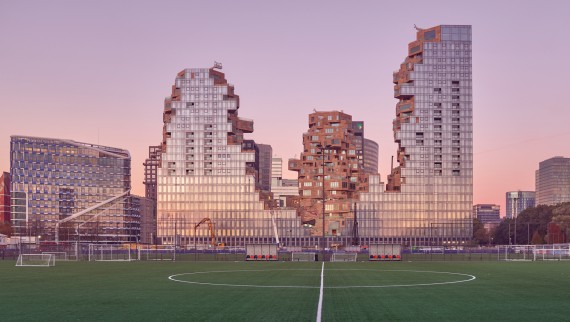Set in stone The Valley, Amsterdam (NL)
“The Valley“ offers high-quality living space in the middle of Amsterdam. The public area of the building was awarded the BREEAM Excellent sustainability certificate. The sanitary competence of Geberit also contributed to this achievement.
The building will hardly look in reality as it does in the illustrations, Dutch architecture critic Mark Minkjan complained in 2016 about the first visualisations of the project. But the “The Valley”, as the building complex in the Zuidas high-rise and financial district in Amsterdam is called, has been standing since 2021, and it looks remarkably similar to the renderings.
A valley in the land of sinks

The initial scepticism is not surprising. “The Valley” challenges the familiar notion of architecture. It is reminiscent of a quarry from whose interior building material is extracted. On the outside, the walls of the building complex are smooth, covered with a mirror skin. Inside, a rugged rocky gorge opens up.
198 flats between 55 and 400 square metres accommodate this urban mountain in its three towers, which are up to 102 metres high. The base is reserved for public use. Offices, shops, restaurants, a swimming pool, a gym, exhibition spaces and a natural history museum are housed on five floors.
Green outside and inside

Nature is an integral part of this architectural work. Piet Oudolf, the grand master of Dutch landscape gardening, was commissioned with the planting. Planting? The term falls short in view of the vertical garden landscape that Piet Oudolf has realised in “The Valley“. 155 plant varieties grow on the ten storeys. While flowering shrubs and trees grow on the lower floors, it is mainly Mediterranean herbs that survive on the upper terraces.
But this is not the only reason why “The Valley“ is considered a “green“ building. “The Valley“ is a so-called “plus energy building“ and generates more energy than it draws externally. Photovoltaic systems on the roofs, district heating and triple glazing, underfloor heating and cooling all contribute to this energy efficiency.
Trust in Geberit

Geberit also contributes to the “BREEAM-NL Excellent“ rating of the BREEAM certification standard, which was awarded to the lower, public floors. After all, efficient water supply and waste water disposal are also important criteria for the certification of sustainable buildings. “The careful use of water was an important topic from the very beginning,“ recalls Jeroen Kemmink, the project manager responsible on Geberit's side.
In order to be able to guarantee the minimum flush volume with optimal flushing of the WCs, the piping systems were optimised and the water paths shortened. For this purpose, the builders opted for the efficient SuperTube drainage system - and only during the construction process. “The close support was a prerequisite for us to be able to implement this solution together,“ says Jeroen Kemmink. “It would not have been possible without many years of cooperation and mutual trust.“